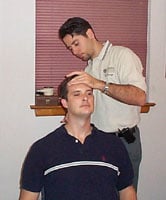Treating a Whiplash with Osteopathic Manipulative Treatment(OMT)
Source: orthoinfo.aaos.org/fact/ thr_report.cfm?Thread_ID=232&topcategory=Neck
Imagine yourself driving when a car behind you rear-ends your vehicle. The impact pushes your car forward. It takes about 100 milliseconds for your body to catch up to the forward movement. Your shoulders travel forward until they are under your head, and your neck extends forward as your head tilts slightly down toward your steering wheel. You step on the brakes, bringing the car to an abrupt halt. The sudden stop throws your head and neck backward, and they bounce against the headrest. In a matter of seconds, you've experienced the classic mechanism of injury for whiplash.
About 20 percent of people involved in rear-end collisions later experience symptoms that center in the neck region. Although most of these people recover quickly, a small number develop chronic conditions that result in severe pain and sometimes disability.
Signs and symptoms
People who experience whiplash may develop one or more of the following symptoms, usually within the first two days after the accident:
Neck pain and stiffness
Headaches
Pain in the shoulder or between the shoulder blades
Low back pain
Pain or numbness in the arm and/or hand
Dizziness
Ringing in the ears or blurred vision
Difficulty concentrating or remembering
Irritability, sleep disturbances, fatigue
Diagnosis and Treatment
How whiplash injuries occur is clearly understood, but the extent and type of injuries varies greatly. The diagnosis of whiplash is often one of exclusion. Most injuries are to soft tissues such as the disks, muscles and ligaments, and cannot be seen on standard X-rays. Your doctor may need to request specialized tests, such as computed tomography scans or magnetic resonance imaging (MRI).
In the past, whiplash injuries were often treated with immobilization in a cervical collar. However, the current trend is to encourage early movement, rather than immobilization. The soft collar may be used for a short term and on an intermittent basis.
Ice may be applied for the first 24 hours, followed by gentle active movement. Your doctor may provide you with a series of exercises that you can do at home. An early return to work is encouraged, even if your doctor must prescribe some temporary modifications in your work situation. No single treatment has been scientifically proven as effective, but pain relieving medications, exercises, physical therapy, traction, massage, heat, ice, injections and ultrasound have all been beneficial for some patients.
As soon as possible, you should begin aerobic activities, such as walking. Your doctor may prescribe some isometric exercises as your condition improves. Symptoms resolve within several months for about 75 percent of people who have whiplash. Chronic conditions should be investigated further and might require surgery.
Where OMT comes in handy.....
OMTs can be applied to a variety of health problems, both musculoskeletal and non-musculoskeletal. According to the US Department of Health and Human Services, OMTs are most effective for back and neck pain. In fact, if you have back pain, you may be able to reduce the amount of pain medication you are taking if you receive OMT as part of your therapy. One study showed that patients with pancreatitis were able to go home from the hospital sooner when they had OMT.
In one small study, people with Parkinson's disease were able to walk better after only one session of OMT. Another study looked at 38 patients who had knee surgery. Those who had OMT were able to walk up stairs 20% earlier than those who did not have OMT.
A study of 100 people with high blood pressure treated only with OMT showed that OMT produced significant reductions in blood pressure.
Studies show that OMT eases breathing, drains the sinuses and relieves the symptoms, duration, and recurrence of the common cold.
Osteopathy may also be an effective way to treat carpal tunnel syndrome. More studies are needed to confirm this.
Examples of other conditions for which OMT may be helpful include:
stress-related problems (such as tension headaches, muscle spasm)
strains and sprains (especially of the neck and back)
shoulder pain
osteoarthritis
headaches
painful menstruation
injuries (such as whiplash)
scoliosis (side to side curvature of the spine)
infantile colic
insomnia

0 Comments:
Post a Comment
<< Home